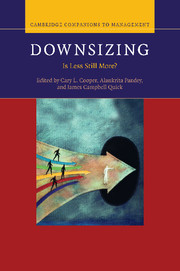Book contents
- Frontmatter
- Contents
- List of figures
- List of tables
- List of contributors
- Foreword
- Preface
- Part I Overview
- Part II Human outcomes
- 4 Human motivation and performance outcomes in the context of downsizing
- 5 To downsize human capital
- 6 Health effect outcomes
- Part III Organizational outcomes
- Part IV Post-downsizing implications
- Index
- References
5 - To downsize human capital
A strategic human resource perspective on the disparate outcomes of downsizing
Published online by Cambridge University Press: 05 July 2014
- Frontmatter
- Contents
- List of figures
- List of tables
- List of contributors
- Foreword
- Preface
- Part I Overview
- Part II Human outcomes
- 4 Human motivation and performance outcomes in the context of downsizing
- 5 To downsize human capital
- 6 Health effect outcomes
- Part III Organizational outcomes
- Part IV Post-downsizing implications
- Index
- References
Summary
The process of downsizing is defined as the “planned set of organizational policies and practices aimed at reducing the extant workforce with the goal of improving firm performance” (Datta, Guthrie, Basuil, and Pandey, 2010, p. 282). It is a very complex process, far more so than research following only an economic or institutional view would suggest (McKinley, Zhao, and Rust, 2000). Whether the impetus to consider downsizing is a reaction to organizational decline or competitive pressures, the impact resulting from the design and execution of the entire process is deeply rooted within the organization and much deliberation and care must go into the proactive planning and implementation of the workforce reduction to temper or eliminate negative outcomes (Cameron, Freeman, and Mishra, 1991). Involving multiple actors and units of analysis, downsizing must be studied in ways taking into account this complexity in order to capture the full effects resulting from such a critical strategic decision.
Downsizing is an intentional process focusing on improving organizational efficiency through the reduction of employees (Cascio, 2010). The effects of downsizing on the workforce are both foreseen and unforeseen (Huber and Glick, 1993). Organizations undertake downsizing with the assumption that it preserves profitability by enhancing organizational efficiency and reducing costs (DeWitt, 1998; Freeman, 1994; Harrigan, 1980). However, the extant research shows that downsizing yields mixed results. For example, it has been found to have positive effects (Baumol, Blinder, and Wolff, 2003; Bruton, Keels, and Shook, 1996; Espahbodi, John, and Vasudevan 2000; Wayhan and Werner, 2000), negative effects (Cascio, 1993; Cascio, Young, and Morris, 1997; Caves and Kreps, 1993; Lee, 1997; Palmon, Sun, and Tang, 1997; Worrell, Davidson, and Sharma, 1991), or no effects (Cameron et al., 1991) on firm performance. These disparate outcomes are in part due to the inherent complexity of downsizing.
- Type
- Chapter
- Information
- DownsizingIs Less Still More?, pp. 134 - 167Publisher: Cambridge University PressPrint publication year: 2012
References
- 3
- Cited by



